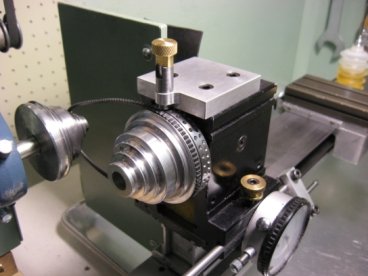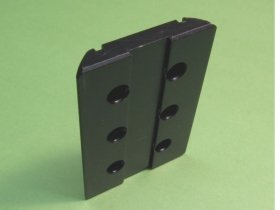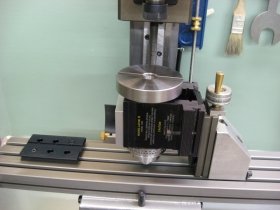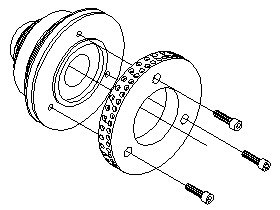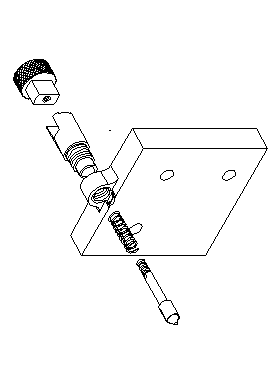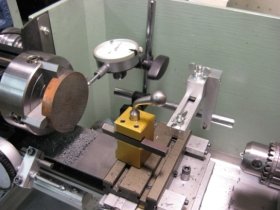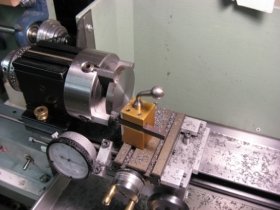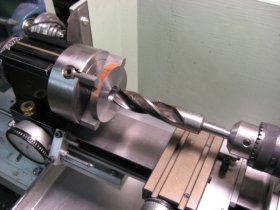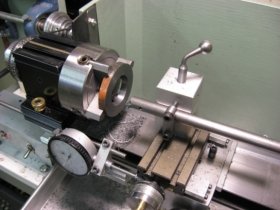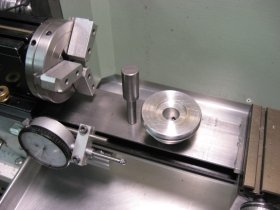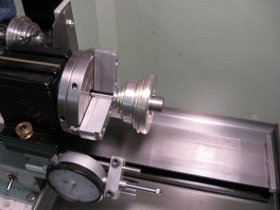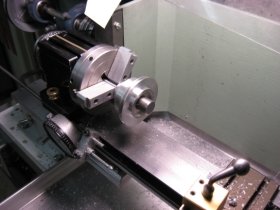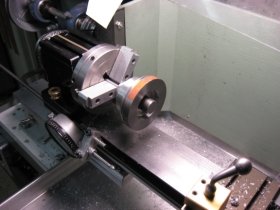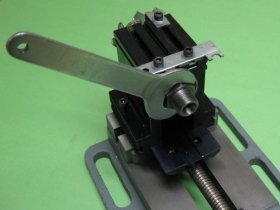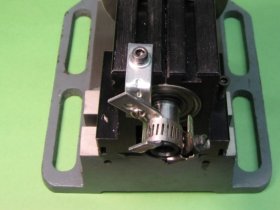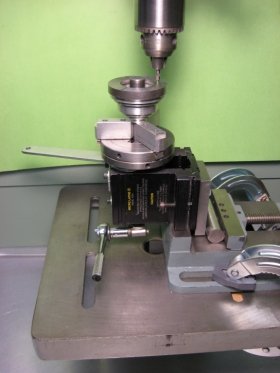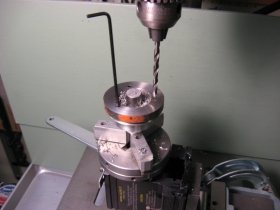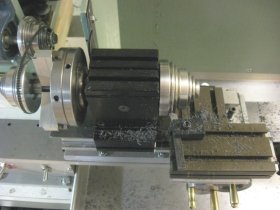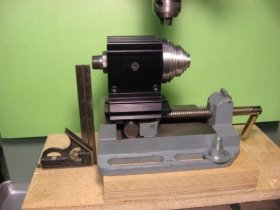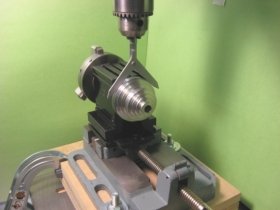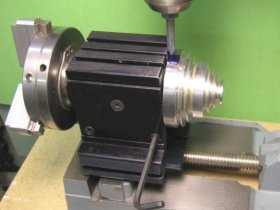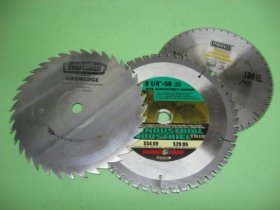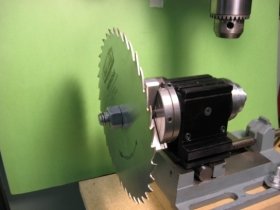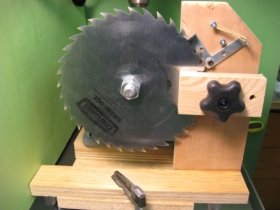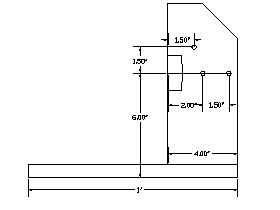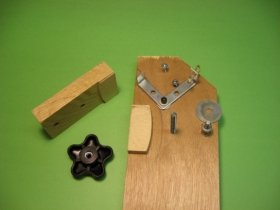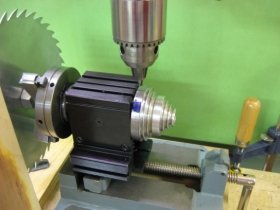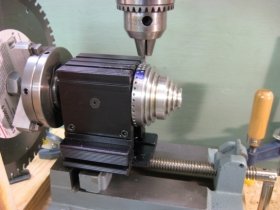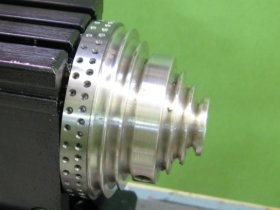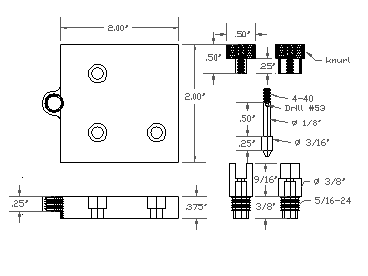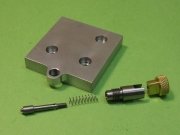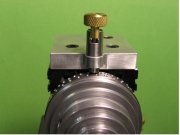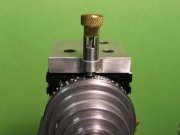An Index Plate for the Taig Lathe
1. Introduction
An indexing plate by itself seems to have limited use on a lathe. It's fine for anything that can be done with a toolpost mounted cutter like scribing divisions on a dial. But for drilling or milling, you need a rotating tool and, therefore, something like a milling spindle mounted on the cross-slide. For light work perhaps a Dremel or flexible shaft would do.
But the Taig design makes that uneccessary. If you think of a second
headstock mounted on the mill table as a kind of poor man's rotary table, you can see that the index plate can now be very useful. Fortunately, Taig makes the mounting easy too. Fig 1.1 shows their milling machine Headstock Mounting Plate, Part 200-48, which is readily available as a spare part. Fig 1.2 shows how natural it is to use this for the mill setup. It's not hard to come up with other mounting techniques as you will see in the following use of the drill press.
2. Design
The indexing values I wanted were relatively few, - 2,3,4 and 6 for general use; 25 and 50 for dials suited to leadscrews with 20 or 40 TPI. But even this minimum needed at least two rows of holes and a detent movable from one row to another. In addition, I already had a couple of attachments which overhung the pulley so that ruled out any plate which would extend above the top of the headstock.
From these considerations, I decided on two rows of 50 and 36 holes respectively drilled radially into a 5/16" thick, 2 1/4" diameter plate. This allows index values of 2,3,4,5,6,9,10,12,18,25,36 and 50, more than
3. Construction
3.1 Pulley Modifications
3.1.1 Making the Index Plate
The index plate is made first so it can later be used as a gauge when machining the pulley. Start with a 3/8" length of 2 3/8" diameter 12L14. This should be long enough to get a finished length of 5/16" even if the initial
faces are not quite square. I had my blank cut off for me by the local metal supplier so it was already reasonably good.
3.1.2 Machining the Pulley
To machine the pulley it must be chucked as the working piece so a second pulley is necessary to drive the spindle. If you have a mill you can borrow
the pulley from it. Otherwise you will probably have to buy one.
3.1.3 Attaching the Index Plate
The index plate is attached to the pulley with 4-40 socket head cap screws. Almost any pattern would do but three screws is kind of elegant and really easy to do with a simple setup on the drill press.The Taig spindle nut is a natural index plate just needing a rotation stop and a spindle lock to produce 2,3,or 6 divisions. The following Figures show how the spindle
wrench provides the rotation, a flat corner brace the stop and a cobbled up small gear clamp the lock. Admittedly, this is not suitable for high precision because the Taig wrench is a pretty sloppy fit on the spindle nut and perfectly repeatable stops are problematic at best. But, with care, it works well enough for this project.
At left this improvised indexing technique is shown set up vertically on the drill-press table. This simplifies placement of the attachment screws at 120 degree intervals.
Use a little medium strength Loctite to hold the index plate in place while drilling the mounting holes. Clamp the setup on the drill press table so as to drill the plate at a diameter of 1 5/8". This is 1/8" outside the radius of the 1 3/8" diameter locating hole.
The pilot holes are drilled 1/2" deep to take 3/8" long 4-40 socket head cap screws. The plate is 5/16" thick so, after a 1/8" deep counter bore, the thread depth is about 3/16". For blind holes in aluminum, I use a #36 pilot
drill for 4-40 and just let the screws self-thread in the holes. It saves time and works very well.
3.1.4 Final Sizing
Maximum concentricity is achieved by finishing the plate with the pulley mounted in its final position on the lathe spindle shaft. Taig pulley bores seem to vary quite a bit in diameter. Some are tight and some loose. In this case, I had to wrap the shaft with .001" brass shim stock to get a good fit.
A friend actually had to bore and bush an extremely loose pulley. If you're adapting your original pulley you should be safe but a new one could be troublesome.
Turn the headstock end for end and mount the spare pulley outboard in the three jaw chuck reversing the previously made machining adapter for use as a mandrel. Use the topslide to be sure the tool can travel right up to the headstock, especially if you have bed wipers installed on the carriage.
True up the plate diameter and reduce to a size you like. In my case, it only had to be enough so that it was below the top of the headstock.
Both rows of index holes will be drilled with the pulley in this position so it can now be regarded as more or less permanently installed.
3.2 Drilling the Index Holes
I've seen quite a few references to improvised indexing techniques using circular saw blades but have never found a detailed how-to description. The following describes how I did it on the drill press but it should work equally well using a mill.
Mount the blade on a mandrel made with a couple of nuts on a short, headless 5/8" bolt held in the three-jaw chuck. Incremental rotation of the blade is controlled and locked with the simple device shown in Fig 3.2.6. The rubber band driven detent is very positive but the blade can still move
under torque. Such movement is prevented by a couple of turns on the hand knob to lock the blade by pinching it tightly between the pads of the disc brake. The assembly is most easily positioned by locking it onto the blade and then C-clamping it to the base.
Here is a detailed look at the Detent/Lock Assembly.
The frame is made from scrap 3/4" plywood. The detent lever is bent from a 3" flat corner brace. It's pivot is a 10-32 socket head cap screw self-threaded into a 5/32" hole. The stop and rubber band anchor are #8 wood
screws. The clamp and spacer bolts are 1/4-20 self-threaded into 7/32" holes from the back. The disk pad thicknesses are 3/8" fixed, 1/8" movable, allowing for any set in the saw teeth. The 2 1/2" hand knob makes locking quick and convenient but an ordinary hex or wing nut would do just as well.
Now the first row of holes can be drilled. Select and lock each tooth of the saw blade to rotate the index plate to each successive hole location. Use a #1 center drill, but only deep enough to come about half way up the 60° countersink. This gives about a 3/32" target cone for the detent.
Remove the detent mechanism and saw blade. Loosen the headstock, slide it along to line up with the line marked for the second row of holes and retighten. Install the next saw blade and reclamp the detent mechanism. Index and drill the second row of holes.
Here is the finished pulley and index plate.
3.3 Detent Assembly
All spring-loaded detents are pretty much the same and there's nothing special about this one.
Try to keep as little material as possible around the point where the detent enters the index plate hole. Otherwise it can be quite hard to see just which hole has been selected.
The #53 hole is to allow an .050 Allen key to be used for both tightening the knurled knob on the plunger and the whole assembly into the mounting plate.
The disengagement feature is not absolutely necessary and is hard to make without a mill or lathe milling attachment. In this case, the whole assembly would just be removed when not in use.
